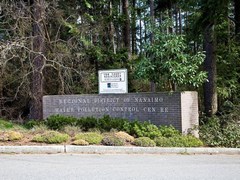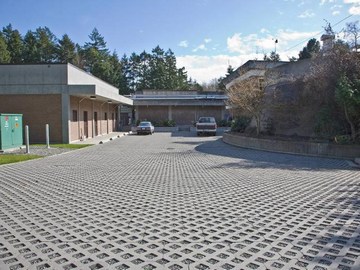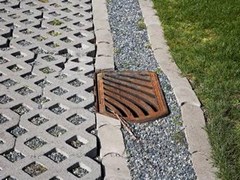Rainwater Management: Practical alternatives to paving at Nanaimo’s Regional Pollution Control Centre
 Paved surfaces present rainwater management challenges, especially when adjacent to fish-bearing streams. The driveway and parking lot at the Regional District of Naniamo’s (RDN) Water Pollution Control Centre on Hammond Bay Road represent a practical response to these issues. Additionally, the technology used is proving to be an attractive alternative to paved surfaces with regard to snow removal and maintenance costs.
Paved surfaces present rainwater management challenges, especially when adjacent to fish-bearing streams. The driveway and parking lot at the Regional District of Naniamo’s (RDN) Water Pollution Control Centre on Hammond Bay Road represent a practical response to these issues. Additionally, the technology used is proving to be an attractive alternative to paved surfaces with regard to snow removal and maintenance costs.
Proximity to salmon-bearing stream:
The development of the RDN’s Centre on Hammond Bay Road took place within a salmon-bearing wetland. Construction required major rerouting of the salmon-bearing stream. The decision to use a permeable surface driveway and parking lot are part of steps taken to have zero run-off/discharge from the parking lots and eliminate site net impact on the stream.

The permeable drivable surface uses a simple technology of concrete blocks filled with sand and gravel. Water, and even effluent leaks (oils, fuels, anti-freeze from  vehicles), are dispersed and treated by natural subsurface soil systems. A storm sewer system is in place (see photo at left) to collect any excess storm waters.
vehicles), are dispersed and treated by natural subsurface soil systems. A storm sewer system is in place (see photo at left) to collect any excess storm waters.
The principal negative factor of this technology is the labour cost for installation, as each piece of concrete tile must be handled and edge pieces have to be cut and fit to non-standardized driveway dimensions. Additionally, the surface is not “snowplow friendly,” the blocks tending to be uneven and catching the plow blade, resulting in breakage of blocks.
Observations:
The snowplow issue is, however, offset by one of the positive features of the technology: experience has shown that simply driving on the snow-covered permeable surface is a more effective way to remove snow than plowing it. The snow is pushed through the blocks, and given the relative warmth of Nanaimo’s winters, it quickly melts away.
Staff have also commented that the permeable driveway, even when it is covered with snow, provides more traction than adjacent paved surfaces. Part of this is due to the inability of ice to form: as the snow melts it seeps into the ground, unlike conventional paved surfaces which allow water to pool under melting snow, creating icy conditions with freezing temperatures in the late afternoon and evening.
While construction of the permeable surface driveway is more expensive than a conventional paved surface, maintenance is considerably less expensive. Special equipment is not required, nor special training. Repairs can be done by an individual with a bucket of sand, a shovel, and a wheelbarrow at most.
Green Value Case Study Profile Series
This case study profile was commissioned by the Real Estate Foundation of BC and prepared by Hans Peter Meyer.
To read about more case study profiles in the series, please click on this link to Vancouver Island Development Projects Illustrate ‘Green Value’ Approaches: Real Estate Foundation and Ministry of Environment fund ‘case study profiles’

November 2007

